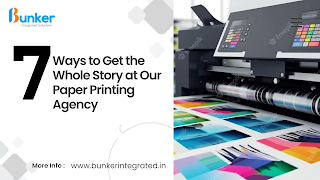What are the latest technological advancements in the printing industry?
Introduction:
The printing agency has undergone significant transformations over the past few decades, driven by rapid technological advancements. These innovations have revolutionized the way we think about printing, making it faster, more efficient, and more versatile. In this blog post, we will explore the latest technological advancements in the printing industry and how they are shaping its future.
Digital Printing:
Digital printing has been a major advancement in the printing industry. Digital printing does not require printing plates, unlike traditional printing methods. Instead, digital files like PDFs or desktop publishing files can be sent directly to the printer, allowing for faster turnaround times and reduced costs.
Advantages of Digital Printing:
fashionable Printing: Digital printing enables businesses to print only what they need when they need it, reducing waste and storage costs.
Customization: Digital printing makes it easy to personalize each print, which is particularly useful for marketing materials aimed at different recipients.
High Quality: Modern digital printers produce high-quality prints with vibrant colours and sharp details.
3D Printing:
3D printing, also known as additive manufacturing, has become a widely adopted technology with its ability to create three dimensional objects by layering materials. Its applications have spanned across various industries such as healthcare, automotive, aerospace, and fashion.
Impact on the Printing Industry:
Prototyping: 3D printing has transformed the prototyping process, providing designers and engineers with the capability to swiftly create and test prototypes before mass production.
Customization: Similar to digital printing, 3D printing offers a high degree of customization, allowing products to be tailored to meet specific needs and preferences.
Reduced Costs: By enabling rapid prototyping and reducing the necessity for expensive moulds, 3D printing has the potential to significantly lower production costs.
Inkjet Printing:
Inkjet printing has been around for a while, and recent advancements have made it more efficient and versatile than ever before. Modern inkjet printers can handle a wide range of materials, including paper, textiles, ceramics, and metals.
Key Innovations:
High Speed Printing: Newer inkjet printers can print at incredibly high speeds without compromising quality, making them suitable for high-volume printing jobs.
Wide Format Printing: Wide-format inkjet printers can produce large prints, such as banners, posters, and billboards, with stunning detail and colour accuracy.
EcoFriendly Inks: Advancements in ink technology have led to the development of ecofriendly inks that are less harmful to the environment.
LED UV Printing:
LED UV printing is a newer technology that uses ultraviolet (UV) light to cure or dry the ink as it is printed. This method provides various advantages compared to traditional printing methods.
Benefits of LED UV Printing:
Faster Drying Times: The UV curing process is almost instantaneous, reducing drying times and speeding up the overall printing process.
Durability: Prints produced with LED UV printers are highly durable and resistant to scratches and fading.
Versatility: LED UV printers can print on a wide variety of materials, including plastics, glass, and metal.
Artificial Intelligence (AI) and Automation
Artificial intelligence and automation are transforming the printing industry by improving efficiency and reducing human error. AI powered software can optimize printing processes, while automated systems can handle tasks such as material handling and quality control.
Applications in Printing:
Predictive Maintenance: AI can predict when a printer is likely to fail and schedule maintenance before problems arise, reducing downtime.
Automated Workflows: Automation can streamline workflows, from order processing to printing and finishing, ensuring a smooth and efficient production process.
Quality Control: AI can monitor prints for defects and make real-time adjustments to ensure consistent quality.
Internet of Things (IoT):
The Internet of Things (IoT) connects printers to the Internet, allowing for remote monitoring and management. IoT enabled printers can communicate with other devices, providing real time data on performance and maintenance needs.
IoT in Action:
Remote Monitoring: Printers equipped with IoT technology can be monitored remotely, allowing for quick detection and resolution of issues.
Supply Management: IoT can track ink and paper levels, automatically reordering supplies when they run low.
Data Analytics: IoT devices can collect data on printer usage, helping businesses optimize their printing operations and reduce costs.
Nanotechnology:
Nanotechnology is being used in the printing industry, particularly in the development of new inks and materials. Nanoparticles can enhance the properties of inks, making them more vibrant and durable.
Innovations with Nanotechnology
Conductive Inks: Nanotechnology has enabled the creation of conductive inks, which can be used to print electronic circuits on various substrates.
Improved Colors: Nanoparticles can improve colour intensity and stability, resulting in more vivid and long-lasting prints.
Anti Counterfeiting: Nanotechnology can be used to create unique security features in printed materials, helping to prevent counterfeiting.
Sustainability and EcoFriendly Printing:
The importance of sustainability is growing in the printing industry. New technologies are being developed to reduce the environmental impact of printing.
Sustainable Practices:
Recycled Materials: Many printers are now using recycled paper and eco-friendly inks to reduce waste and pollution.
Energy Efficiency: Modern printers are designed to be more energy-efficient, reducing their carbon footprint.
Waste Reduction: Technologies like digital printing and 3D printing help minimize waste by enabling fashionable and precise production.
Conclusion:
The printing agency is currently undergoing a technological comeback, with innovations revolutionizing the printing process. From digital and 3D printing to AI and nanotechnology, these advances are making printing faster, more efficient, and more sustainable. As these technologies continue to evolve, we can expect even more exciting developments in the future, shaping the printing industry in ways we can only imagine. Whether you're a business looking to optimize your printing processes or a consumer interested in the latest trends, staying informed about these advancements is essential for staying ahead in the ever changing world of printing.
Contact us:
Mobile No: +91 7676307644
E-Mail: info@bunkerintegrated.in
Website: www.bunkerintegrated.in




Comments
Post a Comment